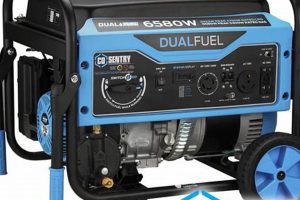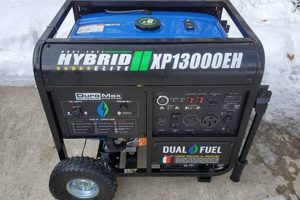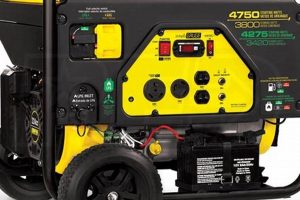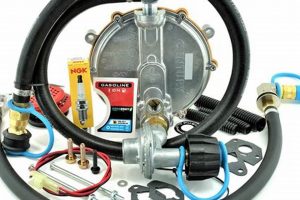A fuel shut-off valve, specifically designed for portable generators manufactured by Briggs & Stratton, is a critical component controlling the flow of gasoline from the fuel tank to the carburetor. This mechanical device allows users to stop the fuel supply, preventing carburetor flooding, stale fuel issues, and potential fire hazards during transport or storage.
Preventing fuel from continuously flowing into the carburetor offers several significant advantages. It safeguards against the risks associated with a flooded engine, a common problem that can lead to hard starting or engine damage. Furthermore, it minimizes the formation of varnish and gum deposits that result from stale fuel left in the carburetor, ensuring optimal engine performance and longevity. By incorporating this valve, Briggs & Stratton has enhanced the safety and reliability of their portable generators, addressing potential hazards and simplifying long-term maintenance. This focus on user safety reflects a broader industry trend towards incorporating preventative measures in power equipment design.
The following sections delve into specific aspects of fuel system maintenance, including proper valve operation, troubleshooting common issues, and recommended replacement procedures for optimal generator performance.
Fuel Shut-Off Valve Tips for Briggs & Stratton Portable Generators
Proper use of the fuel shut-off valve is essential for maintaining generator performance and preventing potential issues. The following tips offer guidance on utilizing this critical component effectively.
Tip 1: Engage the Shut-Off Valve Before Transporting the Generator. This prevents fuel spills and reduces the risk of carburetor flooding.
Tip 2: Utilize the Shut-Off Valve When Storing the Generator for Extended Periods. This practice minimizes the formation of varnish and gum deposits caused by stale fuel, extending engine life.
Tip 3: Turn the Fuel Shut-Off Valve to the “ON” Position Before Starting the Generator. This ensures adequate fuel flow to the carburetor for proper engine operation.
Tip 4: If the Generator Fails to Start, Inspect the Fuel Shut-Off Valve Position. A closed valve may be the cause of the starting failure. Confirm it is in the “ON” position before further troubleshooting.
Tip 5: Periodically Check the Fuel Shut-Off Valve for Leaks. Address any leaks promptly to prevent fuel wastage and potential fire hazards.
Tip 6: If the Fuel Shut-Off Valve is Damaged or Malfunctioning, Replace it Immediately with a Genuine Briggs & Stratton Part. Using non-genuine parts may compromise performance and safety.
Tip 7: When Servicing the Carburetor, Utilize the Fuel Shut-off Valve to Isolate the Fuel Supply. This added safety measure prevents accidental fuel leaks during maintenance procedures.
Adhering to these guidelines ensures efficient operation, prolongs generator lifespan, and promotes safe handling.
By understanding and applying these practical tips, users can maximize the benefits of the fuel shut-off valve and maintain their Briggs & Stratton portable generators in optimal condition for years to come.
1. Fuel Flow Control
Fuel flow control is a critical function managed by the fuel shut-off valve on Briggs & Stratton portable generators. This valve acts as a gatekeeper, regulating the flow of gasoline from the fuel tank to the carburetor. Precise fuel flow control is essential for optimal engine performance, preventing issues such as carburetor flooding and facilitating safe storage. When the valve is in the “ON” position, fuel flows freely to the carburetor, enabling the engine to start and run. Conversely, turning the valve to the “OFF” position completely stops the fuel flow, preventing fuel from entering the carburetor. This action is crucial for several reasons.
Firstly, precise fuel flow control prevents carburetor flooding, a common problem that can lead to difficult starting, rough running, and even engine damage. Carburetor flooding occurs when excess fuel accumulates in the carburetor, disrupting the proper air-fuel mixture required for combustion. By shutting off the fuel supply, the valve prevents this oversaturation, ensuring a proper air-fuel mixture for efficient combustion. Secondly, fuel flow control is essential for safe storage and transport. When a generator sits unused for extended periods, gasoline can evaporate, leaving behind sticky residues that can clog carburetor jets and fuel lines. Closing the fuel shut-off valve prevents these residues from forming by stopping the fuel flow, thus mitigating potential long-term damage and ensuring reliable starting after storage. For example, consider a generator transported in a vehicle. A closed fuel shut-off valve prevents fuel leakage, which could create a fire hazard or release harmful fumes.
In summary, the fuel shut-off valve’s control over fuel flow is essential for preventing carburetor flooding, ensuring reliable starting, and enabling safe storage and transport. This simple yet crucial component significantly contributes to the overall performance, longevity, and safety of Briggs & Stratton portable generators. Understanding its function and proper operation empowers users to maintain their generators effectively and avoid potential issues.
2. Prevent Carburetor Flooding
Carburetor flooding, a common issue in portable generators, poses significant starting and operational challenges. A flooded carburetor, characterized by excess fuel, disrupts the precise air-fuel mixture required for combustion. The fuel shut-off valve on Briggs & Stratton portable generators plays a vital role in preventing this problem, contributing significantly to reliable engine starting and performance.
- Fuel Shut-Off Valve Operation
The fuel shut-off valve acts as a primary control point for fuel flow to the carburetor. When engaged (or in the “OFF” position), the valve completely stops fuel flow from the tank. This simple action effectively prevents fuel from continuously entering the carburetor, mitigating the risk of flooding, especially during transport, storage, or when the engine is not running. For example, transporting a generator with a full fuel tank and an open fuel valve can lead to fuel sloshing into the carburetor, causing flooding. Engaging the shut-off valve eliminates this risk.
- Engine Starting Procedure
Proper starting procedures involve ensuring the fuel shut-off valve is in the “ON” position, allowing fuel to flow to the carburetor. However, if the engine fails to start after several attempts, it’s crucial to check the valve’s position. A closed valve restricts fuel flow, preventing the engine from starting and potentially leading to misdiagnosis of other engine problems. This reinforces the valve’s importance in the starting process and accurate troubleshooting.
- Storage Best Practices
Long-term generator storage necessitates specific precautions to prevent fuel-related issues. Engaging the fuel shut-off valve during storage isolates the carburetor from the fuel supply, minimizing fuel evaporation and the formation of varnish deposits that can clog carburetor components. This proactive measure ensures the generator starts reliably after extended periods of inactivity and reduces the need for carburetor cleaning. For comparison, storing a generator with an open fuel valve can lead to a gummed-up carburetor requiring professional cleaning before use.
- Transport Safety
Transporting a portable generator requires careful consideration of fuel safety. An engaged fuel shut-off valve prevents fuel leaks and spills, reducing fire hazards and environmental contamination. This precaution is especially crucial during transport over uneven terrain where fuel sloshing is more likely. Furthermore, it prevents fuel from entering the carburetor, mitigating the risk of flooding and ensuring a smooth start upon reaching the destination.
The fuel shut-off valve is a fundamental component in preventing carburetor flooding in Briggs & Stratton portable generators. Its proper use is integral to safe operation, reliable starting, and long-term engine health. By understanding its role in preventing carburetor flooding, users can contribute significantly to the longevity and performance of their generators.
3. Reduce Stale Fuel Issues
Stale fuel, a common problem for gasoline-powered equipment like portable generators, can lead to operational difficulties and engine damage. Gasoline, particularly ethanol-blended fuels, degrades over time. This degradation process results in the formation of varnish and gum deposits, which can clog carburetor jets, fuel lines, and other critical fuel system components. The fuel shut-off valve integrated into Briggs & Stratton portable generators plays a crucial role in mitigating the negative effects of stale fuel.
By utilizing the fuel shut-off valve, fuel flow to the carburetor is completely stopped. This action isolates the fuel within the tank, limiting its exposure to oxygen and slowing the degradation process. Consider a scenario where a generator is stored for an extended period, such as over the winter months. With the fuel shut-off valve engaged, the risk of stale fuel impacting the carburetor is significantly reduced. Conversely, leaving the valve open allows fuel to remain in the carburetor, exposing it to oxygen and accelerating the formation of harmful deposits. This can result in starting difficulties, rough running, or even complete engine failure when the generator is needed again. Practical experience demonstrates that generators stored with the fuel shut-off valve closed typically require less maintenance and experience fewer fuel-related starting problems compared to those stored with an open valve.
In conclusion, the fuel shut-off valve is a simple yet effective tool for reducing stale fuel issues in Briggs & Stratton portable generators. Its proper use during storage significantly reduces the risk of fuel degradation and its associated problems. This, in turn, contributes to improved reliability, reduced maintenance requirements, and a longer operational lifespan for the generator. Understanding the connection between stale fuel and the fuel shut-off valve empowers users to take proactive steps to protect their investment and ensure reliable power when needed.
4. Enhance Storage Safety
Safe storage of portable generators is paramount for preventing accidents and ensuring the longevity of the equipment. The fuel shut-off valve on Briggs & Stratton portable generators plays a crucial role in enhancing storage safety by mitigating fuel-related hazards. These hazards include fuel leaks, spills, and the buildup of fuel vapors, all of which can lead to fires or environmental contamination. Proper utilization of the fuel shut-off valve addresses these risks, contributing to a safer storage environment.
- Fire Hazard Reduction
Fuel leaks and spills present significant fire hazards, especially in confined storage spaces. Engaging the fuel shut-off valve prevents fuel from escaping the tank, even if the generator is tipped or jostled. This precaution dramatically reduces the risk of fuel coming into contact with ignition sources, such as sparks or open flames. Consider a scenario where a generator is stored in a shed alongside other flammable materials. A fuel leak from a generator with an open fuel valve could have catastrophic consequences. The fuel shut-off valve acts as a critical safety barrier in such situations.
- Vapor Control
Gasoline vapors are flammable and can accumulate in enclosed spaces, creating an explosive atmosphere. Closing the fuel shut-off valve minimizes vapor buildup by preventing fuel from evaporating from the carburetor. This reduces the risk of explosions and ensures a safer storage environment. This is particularly important in areas with poor ventilation, where vapor concentrations can reach dangerous levels. For instance, storing a generator in a basement with an open fuel valve could lead to a dangerous accumulation of fuel vapors.
- Environmental Protection
Fuel spills pose environmental risks, contaminating soil and water sources. The fuel shut-off valve prevents leaks and spills, minimizing the potential for environmental damage. This is particularly important for users storing generators near sensitive ecosystems, such as bodies of water or areas with delicate vegetation. The valve serves as a simple yet effective safeguard against accidental fuel releases. By preventing spills, the valve contributes to responsible environmental stewardship. A comparison can be made with generators lacking a fuel shut-off valve, where even a small tip could result in fuel leakage and environmental contamination.
- Long-Term Preservation
Proper storage practices, including engaging the fuel shut-off valve, contribute to the long-term preservation of the generator. By preventing fuel degradation and minimizing the risk of corrosion within the fuel system, the valve helps maintain the generator’s performance and reliability over time. This proactive measure reduces the need for costly repairs and ensures the generator remains in optimal condition for years to come. For instance, a generator stored with an open fuel valve might require carburetor cleaning and fuel system repairs before its next use, while a generator stored with a closed valve is less likely to experience such issues.
In conclusion, the fuel shut-off valve on Briggs & Stratton portable generators is integral to safe and responsible storage practices. Its proper use significantly mitigates fuel-related hazards, contributing to fire prevention, environmental protection, and the long-term preservation of the equipment. By understanding and utilizing this critical component, users can ensure a safer storage environment and maintain their generators in optimal condition for years of reliable service.
5. Simplify long-term maintenance
Simplified long-term maintenance is a significant benefit derived from the inclusion of a fuel shut-off valve on Briggs & Stratton portable generators. This simple mechanical component plays a crucial role in preventing issues that would otherwise necessitate more extensive maintenance procedures. By controlling fuel flow, the valve mitigates several problems that contribute to long-term wear and tear. One primary example is the prevention of carburetor gumming and varnish buildup. When fuel is left in the carburetor for extended periods, it evaporates, leaving behind sticky residues. These residues can clog carburetor jets and fuel passages, requiring disassembly and cleaning. Utilizing the fuel shut-off valve during storage prevents this by isolating the carburetor from the fuel supply. Consequently, long-term maintenance is simplified by reducing the need for frequent carburetor cleaning.
Another aspect of simplified maintenance relates to the prevention of fuel system corrosion. Ethanol-blended fuels, commonly used in portable generators, can attract moisture, leading to corrosion within the fuel system. The fuel shut-off valve, when engaged, limits the fuel’s exposure to air, reducing the potential for moisture absorption and subsequent corrosion. This, in turn, minimizes the need for fuel system repairs or replacements over the generator’s lifespan. A practical example can be observed in generators used seasonally. Generators stored with the fuel shut-off valve closed are less likely to experience fuel system corrosion compared to those stored with the valve open, resulting in fewer maintenance requirements before the next season’s use. This translates to cost savings and less downtime due to maintenance.
In summary, the fuel shut-off valve on Briggs & Stratton portable generators directly contributes to simplified long-term maintenance. By preventing carburetor gumming, varnish buildup, and fuel system corrosion, the valve reduces the frequency and complexity of required maintenance procedures. This results in less downtime, lower maintenance costs, and a longer operational lifespan for the generator. The practical significance of this feature is substantial, enhancing the overall user experience and the long-term value of the generator. Understanding the role of the fuel shut-off valve in simplifying maintenance empowers users to proactively protect their investment and ensure reliable operation over time.
6. Prevent Accidental Leaks
Preventing accidental fuel leaks is a critical safety and environmental consideration for portable generator owners. The fuel shut-off valve on Briggs & Stratton portable generators serves as a primary defense against such leaks, protecting users and the environment from the hazards associated with spilled gasoline. Understanding the valve’s role in leak prevention is crucial for responsible generator operation and storage.
- Transport Safety
Transporting a portable generator often involves movement over uneven terrain, increasing the risk of fuel spills if the fuel system isn’t properly secured. The fuel shut-off valve provides a crucial safeguard during transport by preventing fuel from flowing out of the tank, even if the generator is tilted or jostled. This feature significantly reduces the likelihood of fuel leaks, minimizing fire hazards and environmental contamination during transit. For example, transporting a generator in the back of a truck over bumpy roads could cause fuel to spill if the shut-off valve is not engaged.
- Storage Security
Long-term storage presents another potential scenario for fuel leaks. Temperature fluctuations can cause fuel expansion and contraction, potentially leading to leaks if the fuel system isn’t properly sealed. Engaging the fuel shut-off valve adds an extra layer of protection during storage by isolating the fuel tank from the rest of the fuel system. This minimizes the risk of leaks caused by temperature changes or accidental tipping, protecting against potential fire hazards and environmental damage. Consider a generator stored in a shed where temperatures can vary significantly. The shut-off valve provides an essential safeguard against temperature-induced leaks.
- Carburetor Maintenance
Accidental leaks can also occur during carburetor maintenance or repairs. Disconnecting fuel lines without first closing the fuel shut-off valve can result in fuel spills. The valve provides a simple yet effective way to isolate the fuel supply during maintenance, preventing unintended fuel release and ensuring a safer working environment. This precaution is essential for preventing both fire hazards and personal exposure to gasoline. Imagine servicing the carburetor without closing the valve; any disconnection could lead to a fuel spill.
- Environmental Responsibility
Accidental fuel leaks have detrimental environmental consequences. Gasoline can contaminate soil and water sources, harming plant and animal life. The fuel shut-off valve plays a vital role in environmental protection by preventing these leaks. Its consistent use minimizes the potential for environmental damage associated with spilled fuel, demonstrating a commitment to responsible generator operation and storage. Compare a generator with a functioning shut-off valve to one without; the former safeguards the environment, while the latter risks contamination in case of a leak.
The fuel shut-off valve on Briggs & Stratton portable generators is essential for preventing accidental fuel leaks. Its proper use during transport, storage, and maintenance contributes significantly to user safety and environmental protection. By understanding and consistently utilizing this critical feature, generator owners demonstrate responsible ownership and contribute to a safer operating environment.
7. Essential Safety Component
The fuel shut-off valve on Briggs & Stratton portable generators is rightfully classified as an essential safety component. Its function directly impacts the safe operation, storage, and transport of these generators, mitigating several potential hazards. A key contribution of the shut-off valve lies in its ability to prevent fuel leaks. Uncontrolled fuel leaks pose significant fire risks, especially in enclosed spaces or during transport. The valve’s ability to completely stop fuel flow from the tank acts as a critical safeguard against such leaks. Consider a scenario where a generator is involved in a minor collision during transport. A functioning shut-off valve significantly reduces the risk of a subsequent fuel leak and potential fire. This direct cause-and-effect relationship underscores the valve’s importance as a safety component.
Furthermore, the valve plays a vital role in preventing carburetor flooding. Excess fuel in the carburetor can lead to difficult starting, rough running, and even engine damage. The shut-off valve prevents flooding by controlling fuel flow, ensuring a proper air-fuel mixture for combustion. This contributes not only to operational efficiency but also to safety by minimizing the risk of backfires or other hazardous engine behavior. For instance, attempting to start a flooded engine can result in a backfire, posing a risk of injury or fire. The fuel shut-off valve helps prevent such situations by preventing flooding in the first place.
In summary, the fuel shut-off valve on Briggs & Stratton portable generators is undeniably an essential safety component. Its function in preventing fuel leaks and carburetor flooding directly mitigates significant operational and storage hazards. Understanding its role and ensuring its proper function is crucial for responsible generator ownership and safe operation. Neglecting this component can lead to preventable accidents and compromise overall generator safety. Regular inspection and maintenance of the fuel shut-off valve are vital for ensuring its continued effectiveness as a safety mechanism and for mitigating the inherent risks associated with portable generators.
Frequently Asked Questions
This FAQ section addresses common inquiries regarding fuel shut-off valves on Briggs & Stratton portable generators. Understanding these aspects is crucial for proper operation and maintenance.
Question 1: How does one locate the fuel shut-off valve on a Briggs & Stratton portable generator?
The fuel shut-off valve is typically located near the fuel tank or along the fuel line leading to the carburetor. Consult the generator’s owner’s manual for the precise location on a specific model.
Question 2: What is the proper procedure for engaging the fuel shut-off valve?
The valve typically operates by turning it to an “OFF” position. The “OFF” position is often indicated by a clear marking on the valve itself or in the owner’s manual. This action stops fuel flow to the carburetor.
Question 3: When should the fuel shut-off valve be engaged?
Engaging the fuel shut-off valve is recommended before transporting or storing the generator, and whenever the generator is not in use. This prevents fuel leaks, carburetor flooding, and stale fuel issues.
Question 4: What are the signs of a malfunctioning fuel shut-off valve?
Signs of a malfunctioning valve include difficulty starting the generator, fuel leaks, or a persistent fuel smell even when the valve is in the “OFF” position. A professional should inspect and potentially replace a faulty valve.
Question 5: Can a non-genuine replacement valve be used?
While non-genuine replacement parts may be available, using a genuine Briggs & Stratton part is strongly recommended. Genuine parts ensure proper fit, function, and maintain warranty coverage. Non-genuine parts may compromise safety and performance.
Question 6: How often should the fuel shut-off valve be inspected?
Regular inspection of the fuel shut-off valve is recommended, ideally as part of routine generator maintenance. Check for leaks, smooth operation, and proper engagement. Frequent inspection can identify potential issues early and prevent more significant problems later.
Proper use and maintenance of the fuel shut-off valve are crucial for safe and efficient generator operation. Consult the owner’s manual for specific instructions related to a particular model.
The following section provides troubleshooting tips for common issues related to the fuel system.
Conclusion
This exploration has highlighted the critical role of the Briggs & Stratton fuel shut-off valve for portable generators. Its function extends beyond simply stopping fuel flow; it directly impacts safe operation, storage, transport, and long-term maintenance. Preventing fuel leaks, mitigating carburetor flooding, and reducing stale fuel issues are key benefits that contribute to both safety and performance. The valve’s presence simplifies maintenance by reducing the likelihood of carburetor gumming and fuel system corrosion, ultimately prolonging the generator’s operational life. Its correct usage is fundamental to responsible generator ownership, ensuring both user safety and environmental protection.
Proper operation and regular inspection of the Briggs & Stratton fuel shut-off valve are essential for maximizing the longevity and performance of portable generators. Understanding its function and incorporating it into routine maintenance procedures is crucial for mitigating potential hazards and ensuring reliable power generation when needed. Continued emphasis on proper valve usage will contribute significantly to the safe and efficient utilization of these essential power sources.






